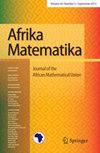Cosmic and thermodynamic analysis of Barrow holographic dark energy model in logarithmic Brans-Dicke gravity
Abstract
This research investigates the Bianchi type-I Barrow holographic dark energy model within the framework of Brans-Dicke gravity theory, incorporating logarithmic scalar fields. We formulate the field equations for a spatially homogeneous and anisotropic spacetime characterized by a configuration of pressure-less matter and dark energy. The Hubble function for the model is derived and constrained using a joint analysis of the cosmic chronometers and Pantheon datasets to obtain values for the model parameters \(H_{0}\) and \(\vartheta _{3}\) at \(1\sigma \) and \(2\sigma \) confidence levels. Based on these parameter values, we compute derived parameters and discuss the results by illustrating the geometrical behavior of cosmological quantities. In this context, we analyze the graphical behavior of the cosmological and dynamical parameters of the proposed model. Stability is examined through the squared sound speed criterion. The proposed framework may potentially address the cosmic coincidence problem. Furthermore, we assess the validity of our model by analyzing thermodynamic quantities. All cosmological evaluations suggest that a suitable choice of model parameters results in an accelerating universe. The suggested model exhibits stability in the early and present epochs but becomes unstable in the later stages.

 求助内容:
求助内容: 应助结果提醒方式:
应助结果提醒方式:


